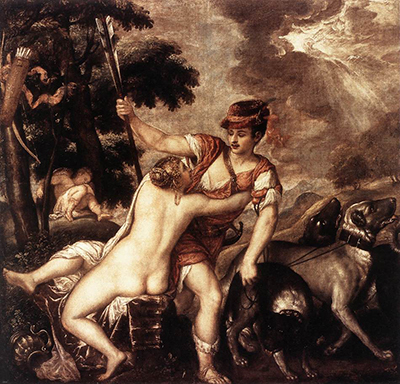Venus and Adonis is a historical painting that was painted by Titian Vecelio.
The painting reflects the Italian tradition since Titian was from Italy. The artwork dates between 1555 and 1560. The painting reflects Venus, a goddess, trying to stop Adonis, her lover, from going to the hunt. As detailed in the catastrophic love story written in Ovid's Metamorphoses, the fairy tale does not end well. Adonis is impassive and does not listen to Venus. In the end, Adonis is devoured by a wild boar while hunting.
Titian used different compositions to give the painting a sense of naturalness and motion. The dynamism of this painting originates from the twisting caused by Venus's obstinate pose, reflecting an ancient sculptural relief. Also, it is referred to as Venus and Adonis 1559 since that is the last year of its painting.
The composition is described by applying a multitude of scientific methods used to investigate pigments, features, imaging layers, and computation of the painting. Based on National Gallery of art and J. Paul Getty Museum, the painting employed several pigments as discussed. Adonis's belt used orpiment pigmentation while the brown colour of the dogs represents brown ochre pigmentation. The red cloth wrapped over Venus's seat and the red tunic of Adonis represents the use of madder lake or carmine pigmentation. The pale blue sky represents smalt, lead white, and natural ultramarine. Adonis's red sleeve represents Vermilion while her shoe represents realgar. The blue mountain represents natural ultramarine. Yellow ochre and Copper resinate are used to paint the meadow next to the golden vase.
The 160 by 196.5 cm painting was prepared using oil as the medium and canvas as the main support material. These materials were easy to prepare and widely used during the high renaissance art period, which the painting belongs to. The materials used enabled effective use of rich colours, shimmering highlights, poignant mood, and a lush landscape that gave the painting evocative sense.
Arguably, the painting was a newer version of the original composition of Farnese. The Farnese painting disappeared in the mid-1540s. Titian was a competitive artist whose work was copied by other artists, especially the nude arts. At least five versions of Venus and Adonis 1555 were painted by different artists. Also, this painting is Shakespeare's narrative poem published in 1593. This poem is conceded as Shakespeare's first publication. Lastly, Lope de Vega, a Spanish dramatist was inspired by the painting and mentioned it severally in plays and used a print of the painting as a stage prop.
Titian painted mythological series of art for King Philip II of Spain. These pieces of art were referred to as Poesie paintings which inspired Ovid's Metamorphoses. The Poesie was a series of narrations which celebrated mortals, goddess, and the love of ancient gods. The poesie paintings include Danae with a Nurse 1553, Danae with Eros 1544, Diana and Actaeon 1556, Diana and Callisto 1556, Rape of Europa 1559, Death of Actaeon 1562, Perseus and Andromeda 1554, and Tarquin and Lucretia 1568.
The painting has passed through many hands of ownership. It was owned by Giovanni Vincenzo until 1648 as indicated in the oldest records. The painting has had more than twenty five owners since then. Currently, the painting is owned by J. Paul Getty Museum after buying it from Gooden & Fox Ltd in 1992.




